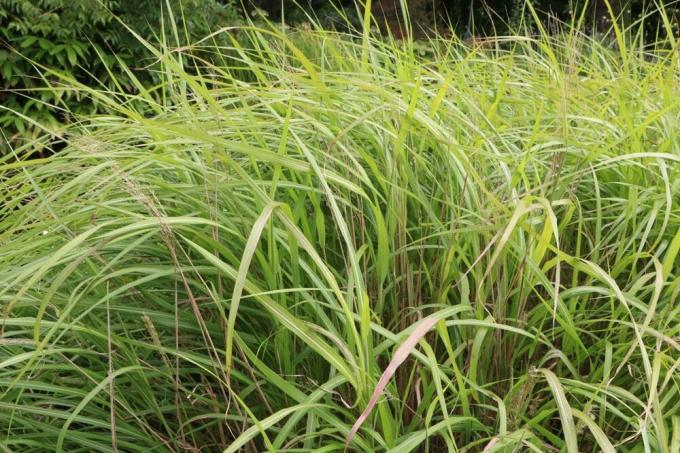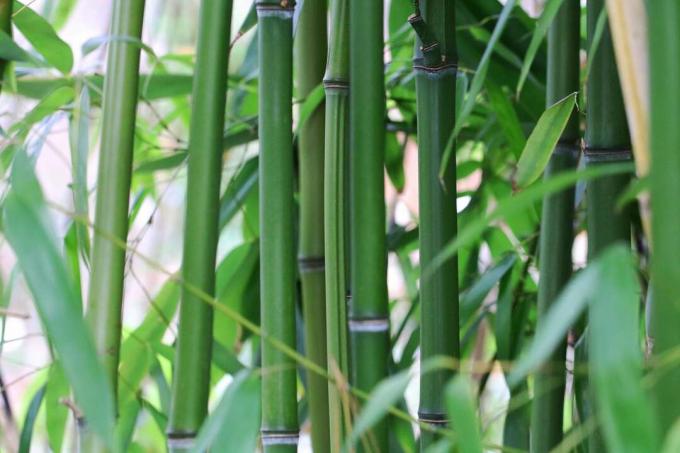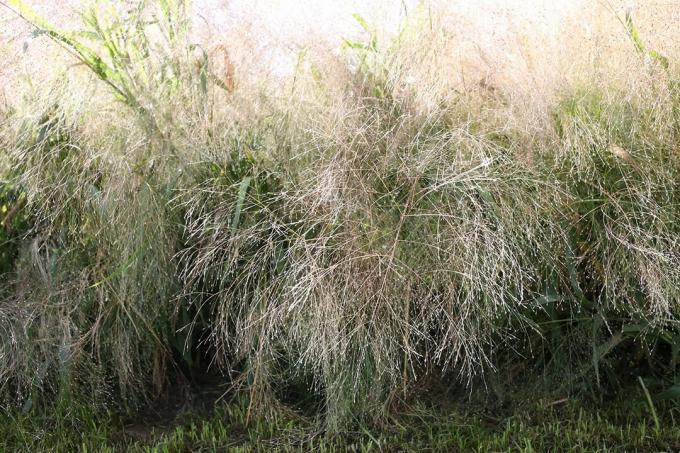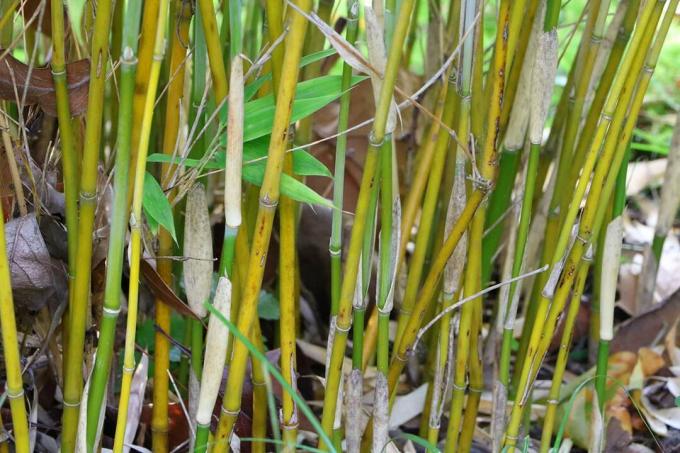

Table of contents
- Location
- substrate
- watering and fertilizing
- Cut
- hibernate
- Plant
- multiply
- diseases and pests
- Brown leaf discolouration
- mealybug infestation
Impressive, decorative and easy to care for - anyone who decides to cultivate Chinese reed as a hobby gardener can look forward to a real eye-catcher in their home garden. The lush plant with the long reed leaves and the dark violet flower panicles is probably originally native to the subtropical regions of central Japan, but is also increasingly found in central Europe cultivated. Here, the plant, which is up to four meters high, also serves as a hibernation quarters for microorganisms such as beetles or spiders. In this way, the hobby gardener also offers useful habitats.
Location
Although Chinese reed comes from Asia and is used to the climatic conditions there, the plant also does well in Central Europe. Above all, the plant has adapted to the conditions in this area in recent years; for example, the flowering period is planned for the end of summer.
However, careful site selection is of great importance to ensure thriving and lush growth. The hobby gardener should choose a place for the plant that meets the following criteria:
- preferably sunny location
- sufficient brightness
- however, light shade is also tolerated
Even if the plant also develops in locations with only moderate sun exposure, the location must not be too shady; The result is weak growth and poor flowering. In addition, if it is constantly in the shade, the entire plant will be weakened and more susceptible to disease.
So that the plant can develop optimally, sunny borders and perennial beds are the most suitable locations.
substrate
In order for the Chinese reed to feel comfortable, the hobby gardener should also attach importance to the right substrate in addition to a suitable location. The plant is basically tolerant in terms of general soil requirements; however, it must not be too dry. Overall, the following criteria should be considered when choosing a substrate:
- sufficient nutrients in the substrate
- humic properties
- moist but permeable consistency
- Enrichment with peat or compost
- no soil compaction
Tip:
When keeping Chinese reed, good drainage is recommended, which ensures optimal drainage. On the other hand, the plant thrives less well on permanently moist soil.
watering and fertilizing
Chinese reed prefers moist soil; for this reason it is necessary to water the plant regularly. The frequency and amount of water supply also depends on the individual location and also on the substrate that was used for cultivation; If the plant is in semi-shade, both the amount and frequency of watering can be reduced, while frequent watering is required in full sun. Freshly planted plants need a lot of moisture.
Regardless of the given amount of water, well-functioning drainage is also important to avoid standing water. It requires a bit of finesse to achieve a constantly slightly moist soil on the one hand and not to cause waterlogging on the other.
With regular watering, the plant basically gets everything it needs to live; additional fertilization is not absolutely necessary. Only if no humus-rich and fertile substrate has been chosen for cultivation should one resort to a targeted administration of nutrients. The following aspects must be taken into account here:
- the administration of complete fertilizer is recommended
- ash from the oven can also be used
- Manure or liquid manure should not be used
- in the year of planting is not fertilized
Cut

Regular pruning of the plant is part of caring for the Chinese reed. Plant experts do not agree on the optimal time for this measure. On the one hand, a targeted pruning is recommended as early as autumn so that it can quickly sprout again in spring. On the other hand, the cut can also cause damage to the plant; since the stalks of the Chinese reed are hollow, there is a risk of water accumulating inside them during the cold season. As a result, the plant begins to rot. In addition, the fronds also offer decorative advantages, which - covered with hoarfrost in winter - represent a visual highlight within the domestic green area. In addition, the tufts covered in snow add structure to the garden.
Regardless of the time of the pruning, the following aspects are important for this measure:
- cut back the plant close to the ground
- cut in bunches
- Use pruning shears with high leverage to cut
- Wear gloves when cutting (risk of injury from sharp edges!)
hibernate
Chinese reed is one of the plants that can be overwintered without any problems; even in rough locations there is usually no risk of the plant freezing to death. In order to offer natural winter protection, pruning is not necessary in autumn; otherwise, no additional protective measures are required for mature plants. Only young reeds should be protected from low temperatures, as they are not yet hardened. In addition, it can make sense to apply winter protection to plants that are cultivated in tubs or pots.
Then the following measures are necessary:
- Tie loose reeds together to avoid damage from snow loads.
- Place the bucket on a styrofoam board
- Wrap pots with fleece
It is often advised that reeds do not need to be tied together; however, this recommendation mainly applies to older specimens. If the plant was grown in the same year, it has proven useful to offer the plant some protection during the cold season; then it will become stronger and more resistant over time and easily survive the following winters without further protection.
Tip:
Some varieties are particularly robust against snow. The Chinese reed 'Silberfeder' (Miscanthus sinensis), for example, straightens itself up again when the snow load has been roughly removed.
Plant
If you want to plant Chinese reed in your garden, you should wait until spring; May is the best time to expose the plant. As a rule, the plant is only available from online providers at this time; but even in the period between the end of June and the beginning of July, when local nurseries offer the plant, it is still worth growing.
When planting, it has proven itself to calculate enough space for the Chinese reed in advance, so that the plant can be optimally used within the domestic green area. For the taller varieties, an area of one square meter is recommended. The plant is particularly decorative in combination with coneflower, torch lily and phlox, which should therefore be cultivated in the immediate vicinity of Chinese reed. The following aspects should be considered when planting:
- Maintain a planting distance of between 30 and 120 cm (depending on the variety)
- Attach a rhizome barrier if there is a high-maintenance green area nearby
- Spread can also be slowed down by using bottomless mortar tubs as planters
- Water the reeds well
- Remove weeds regularly, as young plants are sensitive to competition from roots
multiply
Anyone who cultivates Chinese reed usually does not need to worry about active propagation of the plant. It is a fast-growing plant that spreads quickly in the garden. After just a few years, it is able to take over large areas and push back other plants.
Otherwise, active propagation is uncomplicated by division; this is also done when the reeds have grown too big. Spring is the best time to do this. Then the rhizomes are dug up, which is often very laborious and, due to the very dense root network, is best done with a sharp spade. After digging up and dividing the roots, the grass must be put back in the desired location immediately so that it can then root quickly and grow optimally.
In principle, the targeted sowing of seeds can also be chosen as a propagation method; however, the hobby gardener should be patient in this case, as the plant takes a long time to grow.

diseases and pests
Any plant can be attacked by pests and diseases. Here are the most common problems.
Brown leaf discolouration
Overall, Chinese reed is robust against diseases and pest infestation. Sometimes, however, brown spots appear during the first warm days of spring, which can indicate the following symptoms:
- Rotting of the plant (high risk after cutting off the stalks in autumn)
- lack of water
- sunburn
If the plant is completely rotten, it can no longer be saved; otherwise the growth can be divided and the healthy reed can be reused. If the lack of water is the reason for the discoloration of the leaves, the plant will also look limp overall. Then thorough watering will help. However, if the hobby gardener only sees partial brown spots on the leaves and the plant otherwise looks healthy, it is usually sunburn. These symptoms are often triggered when the Chinese reed is immediately exposed to the blazing sun after moving from the winter quarters to the outside. To prevent sunburn, the plant should be slowly acclimated to the sun; In addition, watering from above should be avoided, since the water droplets on the leaves act like a magnifying glass and can intensify the symptoms. Basically, the newer breeds of Chinese reed with variegated leaves are particularly affected by sunburn; Above all, variants with cross-striped leaves, which are cultivated on dry soil, quickly show these symptoms.
mealybug infestation
In rare cases, Chinese reed is attacked by the miscanthus mealybug, which is mainly found in North America. The presence of the pest can be easily recognized by the cotton ball-like formations on the leaves and by the waxy excretions of the aphid. The following measures help to combat this:
- remove diseased plant parts
- Apply neem oil to the plant
- Use a mixture of spirit, water and curd soap
- Use parasitic wasps or ladybirds as natural enemies of the louse
If the pest has been successfully eliminated, the hobby gardener can then look forward to a healthy expulsion of the Chinese reed. Optimally cared for, he will certainly enjoy the decorative plant for many years to come!
 garden editorial
garden editorial I write about everything that interests me in my garden.
Learn more about ornamental grasses

cutting bamboo | When and how to cut back bamboo?
Be it as a hedge, solitaire or ground cover, bamboo can be seen more and more often in home gardens. Because the sweet grass is easy to care for and easy to grow. However, the latter can quickly become a problem if the plants are not pruned regularly.

11 Tips for Cutting Grasses | Tools & Co.
Cutting ornamental grass works best with our tips: From choosing the right tool to right time - we have the most useful tips and tricks for you for the annual grass cut summarized.

Switchgrass, Panicum virgatum: Care from A – Z
Switchgrass is an upright-growing, clump-forming grass with narrow leaves. The species is considered to be easy to care for and makes few demands on location and soil. Read how to optimally plant and care for Panicum virgatum.

Zebra grass, Miscanthus sinensis 'Strictus': care from A - Z
In botanical jargon, zebra grass is also called Miscanthus sinensis 'Strictus'. The plants can be used wonderfully as privacy screens and are decorative. From care in the tub to overwintering: You can find information on care from A - Z here.

Grow pampas grass from seeds: we explain how
Pampas grass is considered easy to cultivate and can be successfully propagated by breeding. Under controlled conditions in the planter, the germination success is higher than with direct outdoor sowing. The procedures regarding substrate, choice of location and care hardly differ in these variants.

Grasses as a privacy screen: 20 tall grasses
Numerous grasses are ideal as privacy screens! We present the 20 most popular grasses in this article!
